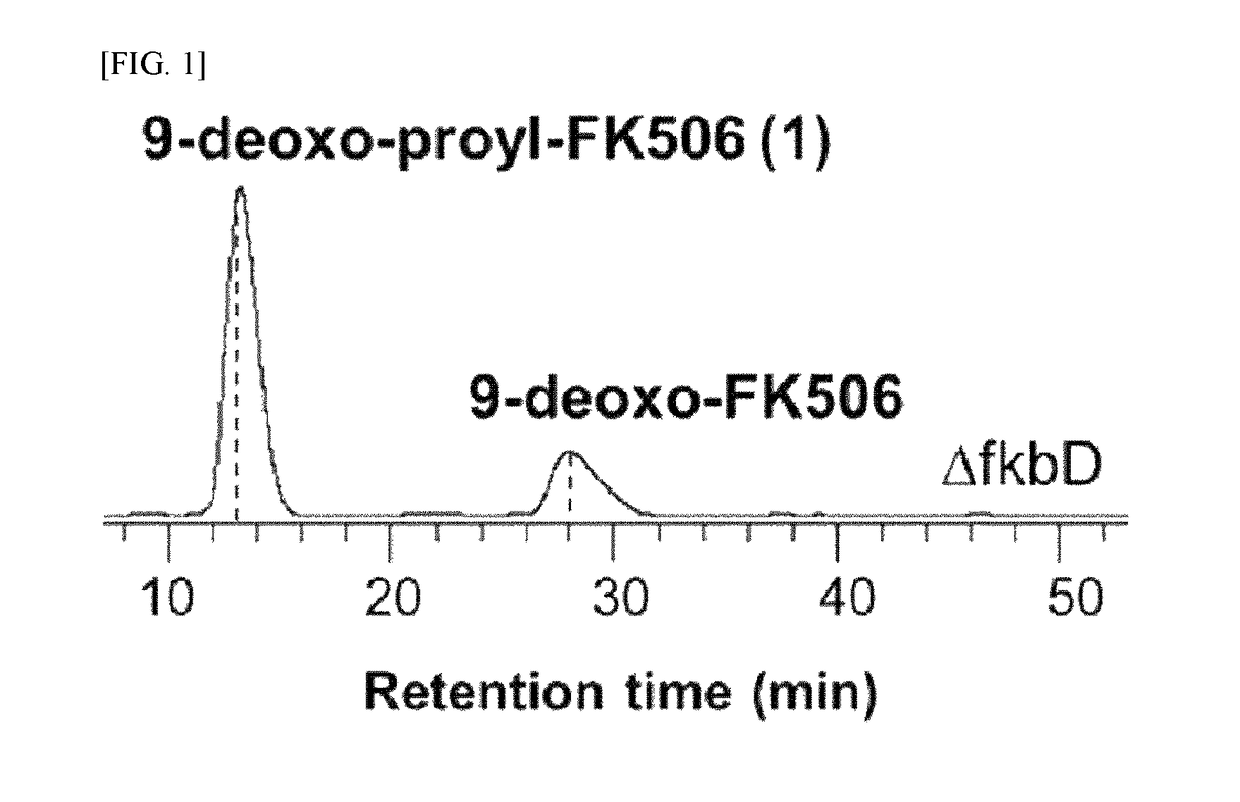FK506 derivative maintaining nerve regeneration activity without immunosuppressive activity, and use thereof
a nerve regeneration and derivative technology, applied in the field of fk506 derivatives, can solve problems such as difficulty in general patients' use, and achieve the effects of promoting neuroregeneration, reducing side effects, and reducing immunosuppressive activity
- Summary
- Abstract
- Description
- Claims
- Application Information
AI Technical Summary
Benefits of technology
Problems solved by technology
Method used
Image
Examples
example 1
Material Preparation Method and Conditions
[0065](1) Construction of Variant and Culture Conditions
[0066]ΔfkbDin-frame strain was prepared by inactivating fkbD gene of Streptomyces sp. KCTC11604BP through an in-frame deletion generated by a double cross-over homologous recombination, according to the preparation method Ban, Y. H. et al. disclosed (J. Nat. Prod. 2013, 76, 1091-1098).
[0067]Spores of the KCTC11604BP strain and the fkbD gene-deleted ΔfkbDin-frame were subcultured on ISP4-agar plates, and seed cultures were prepared in an R2YE medium. 50 mg of vegetative cells grown in the seed cultures for six days were inoculated into 50 mL of the R2YE medium contained in a 250 mL baffled flask and then incubated in an orbital shaker (fixed at 180 rpm) at 28° C. for 6 days.
[0068](2) Extraction and Isolation
[0069]4 L of culture broth of the ΔfkbDin-frame strain was centrifuged, and the supernatant was subjected to solvent-solvent partitioning twice using ethyl acetate. The layer dissolve...
example 2
Observation of the Results of Example 1
[0078]The result of the amorphous white solid analysis is as follows.
[0079](1) HPLC-ESI-MS
[0080]FIG. 1 is a result of HPLC-ESI-MS analysis of the culture extract of ΔfkbDin-frame strain, where ammonium adduct ion peaks eluted at 13 minutes with m / z 793.1 and at 28 minutes with m / z 807.1. Accordingly, the peak eluted at 13 minutes with m / z 793.1 was predicted to be 9-deoxo-prolyl-FK506 based on the fragment ions at 776.1, 758.1, 740.1, and 547.9 as shown in FIG. 2. The fragmentation pattern of 9-deoxo-prolyl-FK506 was similar to that of 9-deoxo-FK506 in that the distance between each of the fragment ions is 14 Da. The characteristic C-1-C-24 fragment ion appeared at m / z 561.9 in 9-deoxo-FK506 whereas the same for 9-deoxo-prolyl-FK506 of the present invention was denoted by an ion peak with m / z 547.9. This implies that 9-deoxo-prolyl-FK506 has one less methylene group in the characteristic C-1-C-24 fragment than 9-deoxo-FK506 and other 9-deoxo-FK...
example 3
Analysis of 9-deoxo-prolyl-FK506 Activity
[0107](1) Analysis of In Vitro T-Cell Activity
[0108]A relative immunosuppressive property of the compound compared to authentic FK506 was determined using T-lymphocytes as described in Mo, S. J. et al. (J. Am. Chem. Soc. 2011, 133, 976-985). Simply, interleukin-2 secretions were quantified after treating the compound (0.1 nM) with CD3 / CD28-activated human T-cells with the compounds for 16 to 20 hours.
[0109]As a result, as shown in FIG. 6, when CD3 / CD28-activated human T-cells were treated with FK506, the interleukin-2 secretion decreased as much as the number of CD3 / CD28-inactivated human T-cells, thereby increasing the immunosuppressive activity. In contrast, when the CD3 / CD28-activated human T-cells were treated with 9-deoxo-prolyl-FK506 (marked as 1) according to the present invention, the interleukin-2 secretion significantly increased to reach that of the normal group, indicating a result opposite to the immunosuppressive activity of the...
PUM
| Property | Measurement | Unit |
|---|---|---|
| flow rate | aaaaa | aaaaa |
| chemical structure | aaaaa | aaaaa |
| HPLC ESI- | aaaaa | aaaaa |
Abstract
Description
Claims
Application Information
 Login to View More
Login to View More - R&D
- Intellectual Property
- Life Sciences
- Materials
- Tech Scout
- Unparalleled Data Quality
- Higher Quality Content
- 60% Fewer Hallucinations
Browse by: Latest US Patents, China's latest patents, Technical Efficacy Thesaurus, Application Domain, Technology Topic, Popular Technical Reports.
© 2025 PatSnap. All rights reserved.Legal|Privacy policy|Modern Slavery Act Transparency Statement|Sitemap|About US| Contact US: help@patsnap.com



